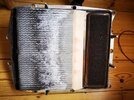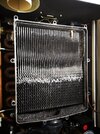Like most boilers, that kind of debris that's found inside the heat engine is more likely to be stuff that's being drawn in from outside and then burned and collecting/attaching on the fins as ash. It is more prevalent in built up areas and shows how much rubbish is actually in the air. That can glow white hot though during the heat cycle and cause damage to the aluminium surfaces. Could it be called corrosion, guess so.
As far as inhibitor is concerned then it can be argued that a well maintained system that uses soft water that doesn't have any leaks can mange quite nicely without any inhibitor. Unfortunately the nature of the water in the UK being so varied with levels of soft and hard water, systems that haven't been cleaned/commissioned properly or need regular top ups due to leaking then inhibitor is a catch all to help minimise corrosion/sludge formation.
I maintain a few old open vent systems that have been in place for years that are squeaky clean and have never needed inhibitor.
As far as inhibitor is concerned then it can be argued that a well maintained system that uses soft water that doesn't have any leaks can mange quite nicely without any inhibitor. Unfortunately the nature of the water in the UK being so varied with levels of soft and hard water, systems that haven't been cleaned/commissioned properly or need regular top ups due to leaking then inhibitor is a catch all to help minimise corrosion/sludge formation.
I maintain a few old open vent systems that have been in place for years that are squeaky clean and have never needed inhibitor.



